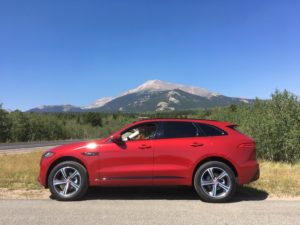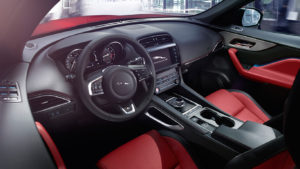
With a new turboed 4-cylinder beneath the hood, the 2018 Jaguar F-Pace set a lead pace on a climb to Allenspark amid fairly heavy holiday traffic on a Sunday morning.
The Jaguar-designed gas engine of 247 horsepower/269 lb.-ft. of torque is a turbocharged 2.0-liter; of course it is, that’s what most all luxury makers are embracing to gain the proper mix of response and economy. Audi’s got one, so do BMW, Mercedes, Lincoln and Volvo.
The turbo in the F-Pace is mated to an 8-speed automatic transmission and all-wheel drive; their popularities are expected to continue a sharp sales increase which has boosted Jaguar in these parts by triple digits.
With the F-Pace compact SUV as its leading seller, Jaguar sales in Colorado in the first seven months of this year reached 293, compared with only 59 in the same period a year ago, a jump of almost 400 percent. Nationally, Jaguar sales have shown a 52 percent gain this year.
Jaguar began a modest sales increase four years ago by adding all-wheel drive to its XJ and XF sedans, then last year pushed the “hot-sales” button with introduction of the F-Pace and the XE compact sports sedan.
The model I tested on the run to Allenspark, with stop for lunch at the old, cozy Meadow Mountain Café, to Estes Park and back home is the ’18 F-Pace 25t R-Sport; the 25t designation is confusing, since the engine is 2.0-liter size.
The 4-cylinder turbo is a welcome addition, though, to the F-Pace, which last year operated with two supercharged V-6s and a 4-cylinder diesel-powered engine.
Big Michelin 255/50 tires on 20-inch wheels provided good road-feel feedback from the Jag, and the 4,000-pounder in driving up and down the hills produced an overall fuel mileage of 25.4 (EPA estimate 22/27). Last year, with a 340-hp V-6, an F-Pace averaged 22.2.
Helping to lead the pace on the climbs from Longmont to Allenspark, then on to Estes Park, I employed the paddle shifters in the F-Pace’s dynamic mode, maintaining excellent control in lower gears, with stiffened suspension (double-wishbone front and multilink rear) and tighter steering. A surprise on restarting the Jag crossover was that it performs in whatever mode it was engaged when it was parked; most others revert to normal mode after shutdown.

The Jaguar’s interior, very comfortable, was brightened with red/orange seat inserts and a large sunroof. Front seats can be lengthened from 20 inches to 22 for thigh support over long drives. Window switches are positioned high up on the sill, while seat-settings are down on the armrests where window controls are normally.
Cruise control was a puzzler at times, often requiring numerous pushes of proper button for setting and increasing or decreasing speeds incrementally.
The F-Pace is 186.3 inches in overall length on a wheelbase of 113.1 inches and sizable cargo space of 33.5 cubic feet. Its tailgate can be automatically opened by swinging a foot beneath the rear of the vehicle.
A base price of $54,175 for the F-Pace was raised to $63,585 with optional add-ons, including the R-Sport package of body cladding and interior trims, 10-inch touchscreen, interactive navigation and driver display, Meridian surround sound system, a lane-keeping assist feature, electrically reclining rear seats, cooled front seats and heated rear seats.